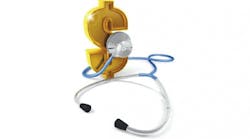Manufacturers and distributors in the medical-device field seem reasonably pleased with how the overall business has been performing. People are generally living longer than ever before, and therefore will need specific medical care—and equipment—as they age. In fact, there is an increasing demand among baby boomers for medical-equipment products, particularly with hip and knee replacements.
Still, this doesn’t mean the medical device and equipment field is one sustained source of profits. Like any industry, it has its ebbs and flows. Sometimes medical-device customers will hold on to a piece of equipment longer than may be advisable.
Ross Kurz, president of WalkMed Infusion LLC, draws a parallel with the auto industry.
“Everyone was driving older cars as long as they possibly could,” he explained. “Our belief is that at some point, similar to autos when people started buying new cars again, we will see a bigger resurgence of demand out there for people to get into new equipment.”
WalkMed Infusion, based in Centennial, Colorado, is a manufacturer that specializes in making infusion pumps, explained Kurz. Much of WalkMed’s customer base consists of independently owned medical practices as well as the oncology market.
“We make two lines of infusion pumps. We have a nice stable niche that we play in which is really outside of the hospitals,” said Kurz. “It is a niche where we can work closely with the owners of practices who are working on a different budget level and complexity of decision-making. They like the fact that we are easy to work with and provide good service. So the smaller companies tend to work well with us.”
Kurz readily admits that his company is often playing David to the large manufacturing Goliaths.
“We obviously compete with companies that are a lot a larger than us…,” he explained. “But we are fortunate in that we have very stable products. We manufacture in the United States, which I believe provides us with a unique advantage versus a lot of companies.”
Kurz said he believes that the company’s size coupled with being a U.S.-based manufacturer gives them a leg up when it comes to customer services.
“As in any business, of course, service is so key. We are able to really have a close pulse on things. So if we have customers with questions or issues, they can talk to our director of regulatory affairs, our director of purchasing,” said Kurz. “It’s not like they’d be calling somebody over in Germany or over in China. They really get that we care.”
An Attractive New Market
The medical device and equipment industry is attracting distributors that specialize in a variety of product lines, as well. Gallagher Fluid Seals of King of Prussia, Pennsylvania, is a distributor of hydraulic and pneumatic packings, seals, and gaskets, among other items. At first glance, it may surprise some to know the company is active in the medical device field, too.
“Typically what we find is that there are a number of different sealing products that a lot of these [medical device] companies use,” explained company president and CEO Joe Gallagher. “Some can be straight rubber parts. Some are injection-molded plastic parts. Some are metal or rubber parts where you take two components and put them together.”
Some of the company’s more successful products are surgical instruments and blood-analyzing machines. In some cases, Gallagher Fluid Seals will use a number of products in its inventory for just one device.
“It depends on the type of equipment and the requirements of the customer. We are involved with a large customer right now where there are probably 10 different parts on this one device we are working on,” said Gallagher. “So they can be complicated at times.”
Gallagher Fluid Seals gets involved in the design aspect of medical devices before the distribution phase, he said.
“Once the equipment is designed and has been tested and approved, we’ll provide ongoing logistic support to our customers. They may want to get [for example] every other week deliveries and shipments,” explained Gallagher. “We might then do some type of consigned inventory or Kanban inventory program for them. Our process is supporting the logistics of their needs and getting the product to the market.”
A large chunk of WalkMed Infusion’s sales are through distributors, said Kurz.
“The majority of our business goes through distributors. It doesn’t mean we do not have sales reps out there that promote it. In the end, our customers don’t want to buy everything in their office from different suppliers. So it is much more convenient for them and for us,” he said. “There are some really great distribution companies out there and their sales reps know the accounts very well. They go into the accounts frequently and really understand their needs.”
When new product training is needed, WalkMed will sometimes work together with its distributors.
“We team up and it varies based on the distributor and the level of expertise of the distributor. We have distributors that are very pump-centric and their reps are great with pumps and they don’t need us as much,” said Kurz. “So it really depends on the distributor and what their focus is.”
Gallagher Fluid Seals, on the other hand, doesn’t get involved in training.
“We are strictly working on the design with the equipment manufacturer. We provide design and consultation for the components that make up the medical equipment,” explained Gallagher. “We work with our supply partner to help the customers finalize design, talk about feasibility, and cost of parts—if things can be ordered or changed. Once the equipment is out there, then that is the responsibility of our customers to be able to train the technicians and things like that. We don’t get involved at all.”
Like many product lines, medical devices and related equipment have seen a great deal of technological advances. Kurz thinks this will be ongoing and points to remote controls and wireless technology as a reason.
“The general expectation is more technology in medical devices,” explained Kurz. “So we are seeing more expectations that all medical devices have increased technology that fit in with our new society of wireless communication and new ways of managing devices.”
Yet there are some concerns in the medical-device industry, including apprehension over what potential impact the Affordable Care Act—while still in its very early stages of implementation—may have on insurance-company reimbursements.
“I’m not making a statement about whether it is a good or bad [law],” said Kurz. “In any change situation, you get into uncertainties. [But] the general expectation is that one of the things that could happen is the reduction in reimbursements.”
Gallagher finds much the same attitude.
“In the healthcare industry the people that are really driving the whole cost situation are the insurance companies. They are only going to reimburse for so much,” said Gallagher.
Kurz also expressed his opposition to the Medical Device Tax that companies such as his must face.
“There’s a lot going on in the industry about that. They are taxing 2.3% of my revenues regardless of whether I make money or not,” said Kurz. “Think about the impact when you’re looking at starting up a new medical investment and what that does across the board. We got into [WalkMed] as an investment. It is a healthy chunk.”
These concerns aside, most are upbeat regarding the future of medical devices as a whole.
“Because of the aging population, I think there is going to continue to be growth in this market,” explained Gallagher. “The baby boomers are just starting to retire and that is going to be a huge market for the medical-device manufacturers and the medical industry in general.”









